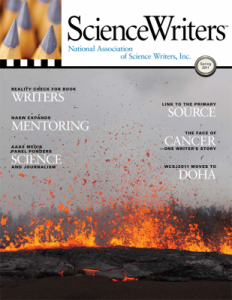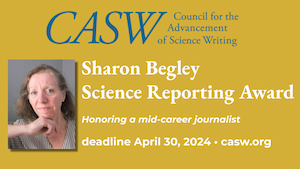At Science Online 2011, a conference for journalists and bloggers in North Carolina, I sat on a panel which considered whether online science journalism could be better than its traditional media counterparts. My first response was “Mother of God, I hope so!”
My vehemence sprang not just from enthusiasm for the improvements possible through linking to primary sources, fostering dialogues with readers, incorporating multimedia and tapping the awesome explanatory power of LOL cats. Rather that online reporting could offer a fresh start — the opportunity to correct major defects in the existing coverage of research. I would like to challenge editors and reporters in all media to reconsider fundamentally how they define science news.
Most categories of news are built around discrete events. A building burns down; a law is passed; a sports team wins a match: these things happen once and they cannot unhappen. News media race to inform the public quickly about these events and the consequences that unspool from them.
Science progresses more gradually, however. Investigators may accumulate findings on one discovery slowly, through repeated experiments. They may discuss preliminary results at scientific meetings. They may write and publish a research paper on their work in a professional journal but others in their field may not accept the conclusions until they have replicated the results, which might later be revised or retracted. There is rarely a distinct moment when a finding or theory comes to be accepted as canon by a consensus of scientists.
Scientific publication is thus like a debutante’s ball: it formally presents a discovery to society but makes no guarantees about its eventual prospects. Yet, journalism typically treats the publication of a paper in a journal as a newsworthy, validating event. The journals themselves encourage that practice by distributing embargoed press releases about the contents of upcoming issues. They oh-so-helpfully identify scientific papers that might be important advances and explain their significance to harried reporters on deadline (in return for a promise not to publish until a set date and time).
The somewhat preposterous consequence of this arrangement is that the news media rely heavily if not exclusively on the embargoed press releases in choosing stories to cover: perhaps because the embargo gives them time to prepare a good story but more compellingly because each news outlet realizes all its competitors will run one. Out of fear of being scooped, all media then publish stories on the same research papers at the moment the embargo ends. In that stampede of coverage, opportunities for distinctive reporting are few. Reporters seek informed, disinterested commentary on the findings from other scientists at other labs, but those scientists are at a disadvantage because the paper is new to them, too. And so they are usually quoted uttering cautious banalities about “results that are exciting if they hold up.”
Because the journals publish new research reports every week, the system has tremendous forward momentum. News writers can rarely look back to see what (if anything) has actually come of past discoveries they have reported previously.
Surely there must be a better way. So consider this (admittedly unrealistic) thought experiment: What would happen if all the editors and reporters of the extended science press, including the legions of science bloggers, self-imposed a moratorium that forbade writing about new scientific findings until six months after their journal publication?
Obviously, reporters could then take more time with their stories and they would have a far wider set of scientists to whom they could turn for commentary, which would in turn be less rushed and better informed. The more important change, however, would likely be to story selection. Many stories now reported breathlessly would probably not be reported at all, or would become parts of more comprehensive roundups of related work. Other discoveries that are now overlooked — because reports of them appear either in less prestigious journals or at the same time as more spectacular work — might finally get their due.
Because “newness” would no longer be a primary factor driving the selection of science news, assigning editors might give more weight to overview stories about trends in research, or the accretion of ideas within fields, or more deeply analytical pieces. Articles could do a better, more thoughtful job of providing context. When different publications did then report on the same research, the stories would be less interchangeable.
Indeed, blogs and science pages offer some such stories already, but doing more of them would be a smarter use of their resources. As a past editor in chief of Scientific American, which was exclusively a monthly science magazine until the 1990s, I can attest that plenty of engaged science readers will happily trade prompt, superficial coverage for something more.
Postponing coverage of research is not a real or preferable remedy to the ills of science journalism. Nevertheless, I do urge publications to rethink and broaden their science coverage. If nothing else, they should consider that, thanks to the web, readers can increasingly find their way to the press releases from journals and research institutions at popular sites such as Science Daily and Futurity.org. If our journalism does not offer substantially more value to readers than these alternative “news” sites, something is wrong.
“Time for change in science journalism?,” The Guardian (online), Jan. 26, 2011.
John Rennie is a former editor in chief of Scientific American and he now writes The Gleaming Retort on PLoS blogs.
(NASW members can read the rest of the Spring 2011 ScienceWriters by logging into the members area.)

.png)

